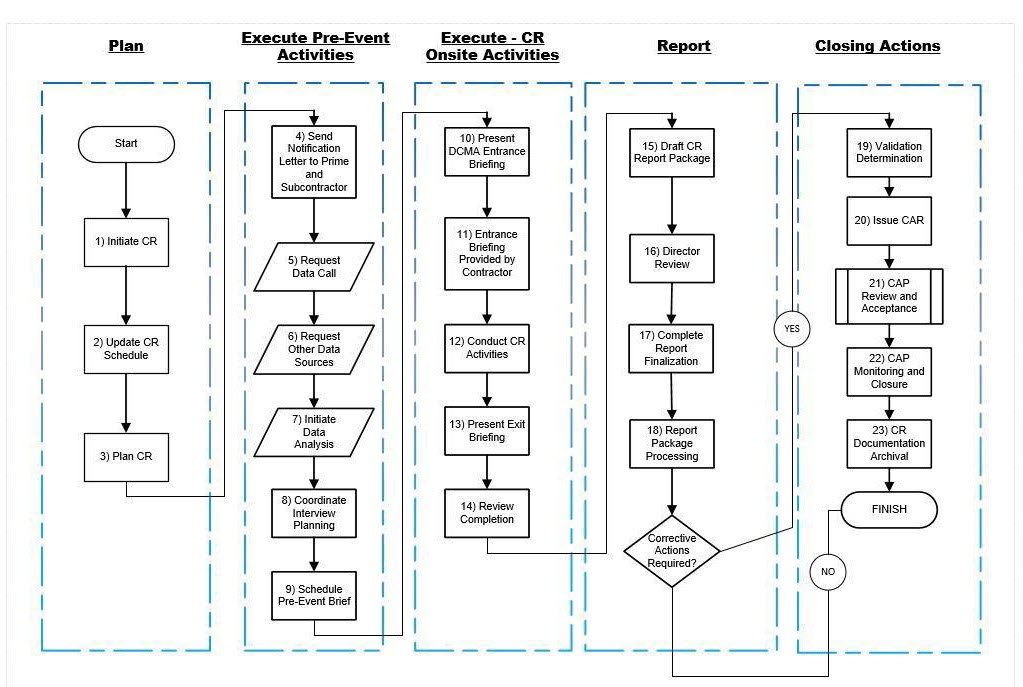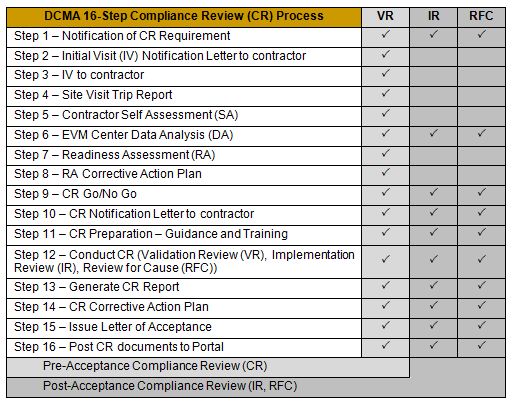Update #1 November 7, 2017
Update #2 December 15, 2020
This is the first topic in a series discussing the DCMA Compliance Review (CR) process. It is the second update to the original series #1 Blog that was based on the instruction book from the DCMA Website that identified the “DCMA 16 Step (and then their 8-Step [UPDATE #2]) EVMS Compliance Review Process.” This change was documented in the DCMA “Earned Value Management System Compliance Reviews Instruction (DCMA-INST 208).” This Instruction has been rescinded and replaced with a set of DCMA Business Practices (BP). These Business Practices split out topics that the old DCMA Instruction 208 covered in one document. Whether you are a contractor new to the EVM contracting environment or a seasoned veteran, if the Earned Value Management System (EVMS) compliance and acceptance authority is the Defense Contract Management Agency (DCMA), these new Business Practices apply to you.
The overall EVMS review processes are covered in the following eight Business Practices (BP):
- BP0 – Earned Value Management Systems (Overarching guidance, overview of the Business Practices)
- BP1 – Pre-Award EVM System Plan Review
- BP2 – System Description Review
- BP3 – Program Support
- BP4 – System Surveillance
- BP5 – Review for Cause
- BP6 – Compliance Review Execution
- BP7 – Compliance Metric Configuration Control (DCMA internal document)
As noted in BP6, “[a] CR is a comprehensive assessment of a contractor’s system, comprised of a System Description (SD), command media, processes, related tools, and the contractor’s ability to implement the EVM system on contracts with an EVMS requirement. The intent is to demonstrate and document compliance to the 32 Guidelines in the EIA-748 EVMS standard. There are three steps for evaluating compliance:
- Assess whether the contractor’s EVM SD adequately documents how its system meets the intent of the 32 Guidelines;
- Evaluate the contractor’s ability to demonstrate the EVMS implementation as described in the SD and supplemental procedures;
- Verify whether the EVMS is providing timely, accurate, reliable and auditable data.”
BP6 defines a uniform process for the DCMA EVMS Center personnel to conduct the planning, execution, and reporting of an initial contractor EVMS Compliance Review (CR), following 23 Steps in 5 major phases or Process Steps (see Figure 1 below from BP6):

This figure shows that the BP6 approach is essentially a combination and consolidation of the 16 Steps and the 8 Step processes in the two prior CR instructions. The tables below show those compliance review process approaches of the old 16 Steps and the 8 Steps:
Table 1. EVMS 16 Step CR Process

Table 2. EVMS 8 Step CR Process
| Process Step | Description |
| 1 | Notification and Data Call |
| 2 | Planning and the Data Analysis (DA) |
| 3 | Opening Meeting |
| 4 | Fieldwork |
| 5 | Communication |
| 6 | Report Writing |
| 8 | Close-Out |
The BP6 process adds clarity on the Review Planning process prior to the Notification steps shown in both the old sets of steps, and then the rest of the BP6 process is consistent with both of the older processes. This is much like the joke about the man who ordered a medium pizza for himself, and the pizza proprietor asked if he would like that cut into 8 pieces or 16 pieces or 20 pieces. The man replied “Hmmm. Eight pieces are probably not enough — I am really hungry, you had better do 20 slices!”
This Business Processes also remains consistent with the change the “8 Step process” made to the “16 Step Process” in that DCMA has removed all lower-level activities that previously involved DCAA and remain DCMA responsibilities. In addition, as part of the data analysis, the current Business Practices incorporate the use of the DCMA EVMS Compliance Metrics (DECM) to isolate any data issues for discussion during the review.
A frequent and common question that H&A consultants are asked is how long it takes to complete the DCMA Compliance Review process. In all the years H&A has been in business, it has varied based on:
§ The current contractual environment,
§ DCMA process requirements, and
§ The resources DCMA has available to do compliance reviews.
In the past, a contractor with an aggressive EVMS implementation plan could complete the process in coordination with the DCMA in about 18 months.
It is a different story today. DCMA is short on the resources they need to do compliance reviews and they have been updating their processes and requirements. The result: it can take up to three years to complete the process. This can have serious implications in those instances where a contractor is contractually required to have a DCMA EVMS Acceptance in place for a project. In some instances, the contract may be near completion or already completed by the time DCMA sends off a notification letter to the contractor.
Unfortunately, the modifications to the CR process have simply cut that “pizza” into 16 slices, then 8 slices, and now 23 slices, meaning that virtually the same process is required, no matter how you cut it. The problem was not the number of steps, but the length of the process (the pizza itself!). The DCMA now intends to do data intensive reviews and to conduct parts of the EVMS review remotely, which could save time and money, hopefully without jeopardizing the integrity of the review process.
What do you do if you find yourself in this situation? One suggestion is to have a discussion with the Director of the EVMS Center to request a waiver from the system acceptance contractual requirement because the compliance review process cannot be completed before the contract completion date.
One critical implication is that each of these process approaches assumes successful accomplishment of each step. Any failure along the way will extend the time it will take a contractor to attain acceptance of their system and implementation. A contractor must be fully prepared to prevent a repeat of any of the steps in the process. It is essential to do things right the first time to prevent further delays. This is a discussion for the next topic in this series – preparing for the EVMS Compliance Review process by conducting internal mock reviews. Since “self-assessments” are no longer formalized in the CR Process, DCMA expects contractors to do internal surveillance and self-identify (and address) EVMS issues to possibly avoid formal Corrective Action Requests (CARs) from DCMA.
Contact Humphreys & Associates for questions about preparing for a DCMA compliance review. Go to our Contact page or email us.

Pingback: EVMS Compliance Review Series #2 – DCMA Contractor Self-Assessment - Humphreys & Associates
Pingback: EVMS Compliance Review 2 – DCMA Contractor Self-Assessment
Pingback: EVMS Compliance Review 2 – DCMA Contractor Self-Assessment
Pingback: EVMS Compliance Review Storyboards – Series #3
Pingback: Updates to the Compliance Review Series of Blogs - Humphreys & Associates
Pingback: EVMS Compliance Review #4 – Preparing for Interviews
I am a DCMA Lead QAS and trying to get clarification on the requirements on does the Government need to notify the contract when they schedule or can they just show up and conduct one. I say that they need to notify the contractor but my Supervisor is telling the team that they can just do one on the spot at any time. To me this would not be good practices and would hold up and dely the contractor IAW FAR 52.246-2/52.246-11
Please help get this confirmed. V/R Billy Wilkerson